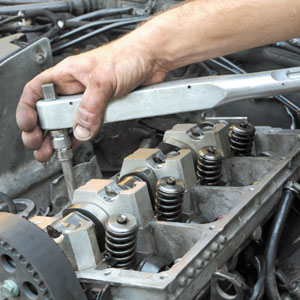Clean Air is Key to Drilling Rigs Maintenance

|
| Everyone knows a diesel engine needs regular maintenance. But a good air induction maintenance program will help keep drilling debris from affecting the lifespan and dependability of the engine. Source: iStock |
Two of the more expensive components of your portable drill rig are the diesel engine and the air compressor. Both of these components are built of large rotating masses that depend on low-friction bearings to turn freely. Bearing life is shortened significantly when there is exposure to contaminants, such as silica particles or other abrasive solids that are by-products of drilling. This is why a good air induction maintenance program is one of the critical requirements for the life of these components. Air cleaners and all of the components that make up the air induction system should be inspected at every oil change interval.
The air cleaner assembly itself consists of many different components that should net you the cleanest possible air for your engine and compressor. At the air cleaner opening, there is a grille that prevents large debris from entering. The air then travels to the bottom of the assembly and is lifted through a series of tubes called the pre-cleaner. This path allows heavier solids to drop from the air stream to the dust pan. On the bottom of the dust pan is a Vacuator valve that will allow the dust pan to drop all solids when the rig is shut off. When the rig is running, negative pressure on the inside of the unit (a vacuum) will pull the Vacuator valve to a closed position that will prevent foreign matter from entering.
The air now enters the upper chamber that houses the primary and secondary filter elements. These elements have seals at both ends, so that they seal at the air cleaner housing and to the center stud and retaining nut. These are the prime dirt stoppers in your air induction system and have now provided the cleanest possible air for your engine and compressor. The air cleaner assembly is fitted with a restriction indicator to help warn you of the performance of the air cleaner assembly. The safety element has a condition indicator on the retaining nut. Once the green dot disappears the element must be replaced.
After the air has been filtered, it must be carried to its destination via a combination of hard piping and rubber hosing. The rubber hosing is typically fastened to the piping with worm drive or T-lock type clamps. When performing your air cleaner inspections, it is important to observe all hosing for cracks. These rubber elements are manufactured to withstand ultraviolet light and extreme climatic conditions for long periods. But not forever! The retaining clamps should be inspected for proper tension that will seal the rubber to the piping. An over-tightened clamp may cut the hose, and a loose or defective clamp will not properly seal the hose. Some piping may be of a welded construction, and these welds should be inspected for cracks. There is no value in having a great filtering system if contaminants are allowed to enter downstream.
To review: Your air induction maintenance program should include the following important actions:
- Remove and clean the dust cap and pre-cleaner tubes.
- Examine the Vacuator valve for condition and proper operation.
- Remove and replace the primary filter element, cleaning and inspecting seals and sealing surfaces in the process.
- Remove and replace the secondary filter element as required. NOTE: The secondary element is typically changed at second maintenance interval. As described above, be sure to clean and inspect seals and sealing surfaces.
- Examine and reset the restriction indicator, as necessary.
- Inspect all hoses and piping for leaks and/or cracks. Replace as needed.
- Check all clamps for tightness.
These maintenance tasks are not very time consuming or costly to perform. A good maintenance program consisting of these low-cost items will ensure manufacturer warrantees in place are honored and will add to the longevity and value of your engine and compressor.
For additional service questions or to speak with a Schramm Service Technician, please call 610-696-2500 or email service@schramminc.com.
Steve Hanley is a veteran service technician with Schramm. For more Tech Topics columns, visit www.thedriller.com/techtopics.
Looking for a reprint of this article?
From high-res PDFs to custom plaques, order your copy today!





